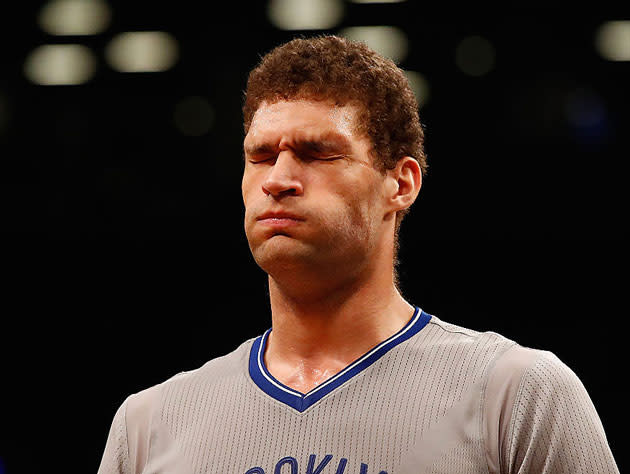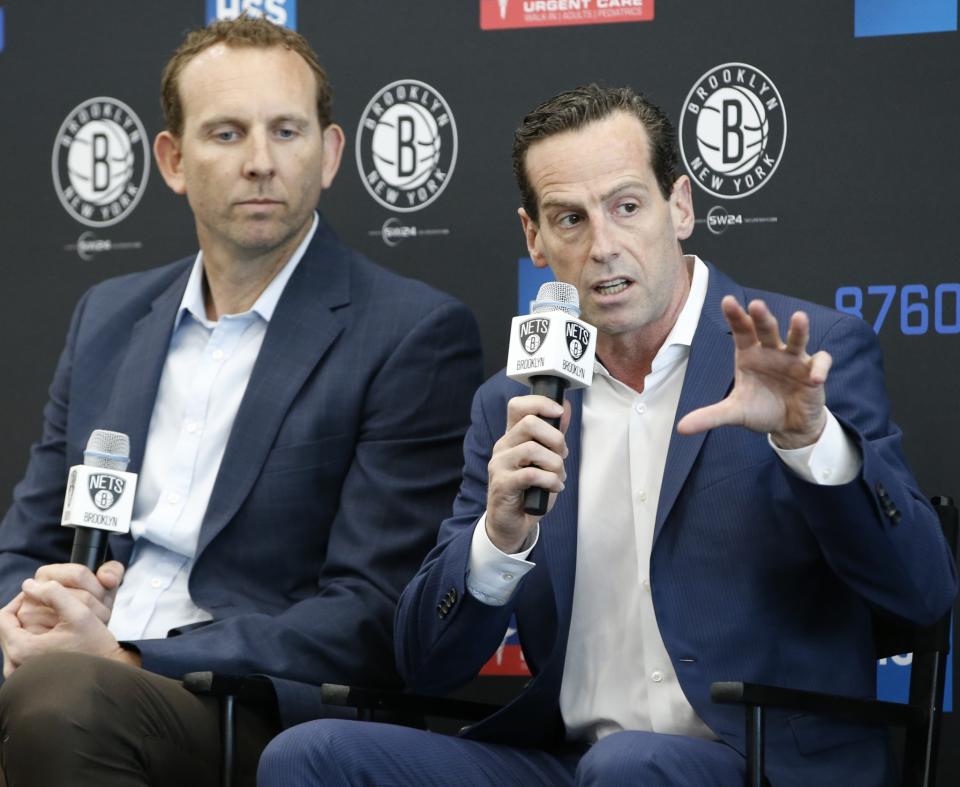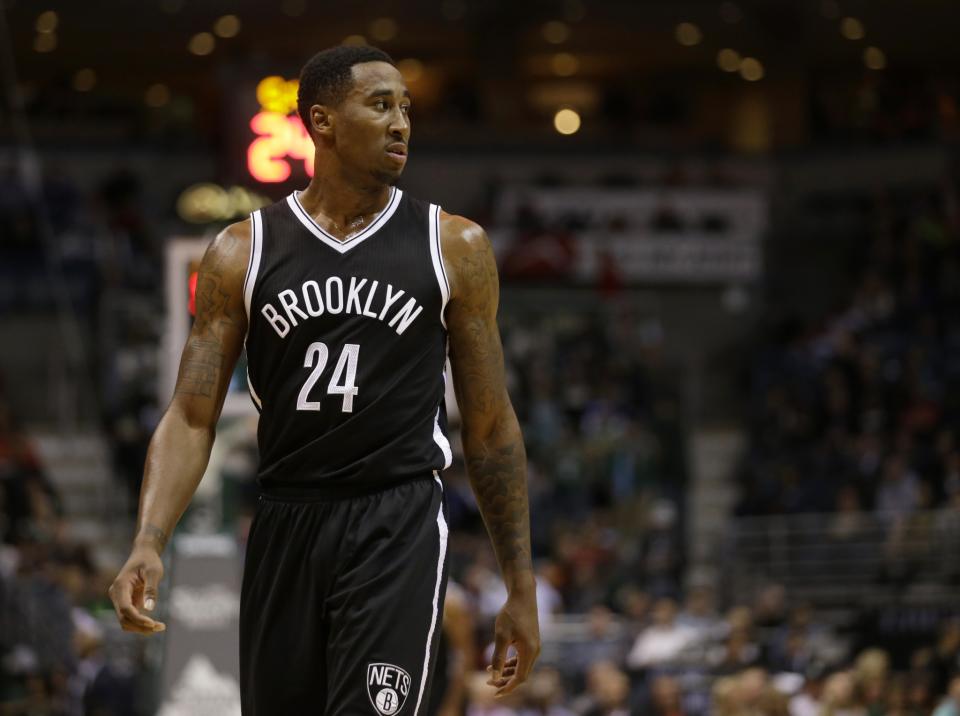BDL's 2016-17 Season Previews: Brooklyn Nets
The Brooklyn Nets reached a point last season where it literally didn’t matter if they won or lost.
[Sign up for Yahoo Fantasy Basketball | Mock Draft | The Vertical | Latest news]
Thanks to the 2013 draft-night deal that sent Kevin Garnett, Paul Pierce and Jason Terry to Brooklyn, the Boston Celtics owned the Nets’ 2016 first-round draft pick. And thanks to the utter disintegration in the years since — the biggest luxury tax bill ever paying for a second-round knockout, the coach bolting to Milwaukee, a failed fire sale, a first-round exit, even more dismantling, etc. — the Nets were well on their way to one of the NBA’s worst records.
They couldn’t win enough to make the playoffs. Inevitable losses brought no relief, because all they did was improve the odds that the C’s — headed to a second straight playoff berth in a rebuild kickstarted by the KG/Pierce trade, by the way — would land the No. 1 overall pick. With a just-hired general manager and an interim coach leading a roster full of players whose contracts were up at season’s end, the air of transience permeated everything at Barclays Center.
The die had already been cast, and for Brooklyn fans, it must’ve felt like the Nets had set out for the Rubicon but wound up crossing the Styx. No NBA team in recent memory has more fully embodied the phrase, “You’re damned if you do, and you’re damned if you don’t.”
The Nets are in an incredible position where there is no incentive to win or lose.
— devin kharpertian (@uuords) April 3, 2016
The pain’s not over yet. Boston has the right to swap first-round choices with Brooklyn in 2017, and owns the Nets’ No. 1 again in 2018. But after completely turning over their front office and coaching staff, tearing the roster down to the studs and starting the process of building for the future, the Nets at least seem to be pointed toward the light again. (Also, with all due respect to Jaylen Brown, at least Nets fans didn’t have to see Ben Simmons or Brandon Ingram wind up in kelly green. Thank heaven for small mercies, and all.)

This year’s roster will feature multiple actual NBA players, plus several young prospects a reasonable observer might consider potential contributors someday. Questions of future consequence will be raised, and the answers will start to come. They’ll likely be attached to another heaping helping of losses, but they’ll come, and they’ll matter. There will be stakes.
After a year in NBA purgatory, the Nets get to return to the land of the living. Returning to relevance might take a little bit longer.
2015-16 season in 140 characters or less:
Lionel Hollins summing up the feelings of Nets fans watching Andrea Bargnani…#NBAhttps://t.co/Y99N8GHcPu
— TAB (@tabcomau) October 30, 2015
The Nets are 64 merciful seconds away from their 60th loss of the season.
— devin kharpertian (@uuords) April 12, 2016
Did the summer help at all?
Yes, mainly because the Nets now seem to have a goal — well, one beyond “throw every asset you have or ever will have at any fleeting glimmer of a chance to win now” — and a plan for how they intend to achieve it.
New GM Sean Marks kicked off his first offseason by letting many of the replacement-level-or-below players who suited up for Brooklyn last year seek employment elsewhere; that many found it in Spain, Russia and China lays bare what kind of roster he inherited. He also bid adieu to interim coach Tony Brown — who we thought acquitted himself pretty well after stepping in for the fired Lionel Hollins, and who will be Scott Brooks’ new lead assistant in Washington — in favor of Kenny Atkinson, who earned raves for his player development work as an assistant with the New York Knicks and Atlanta Hawks, and now gets his first chance to sit at the head of an NBA bench.

Like many first-time drivers, Atkinson’s been handed the keys to a lemon — a Nets team that finished last season with the NBA’s fourth-worst offense and second-worst defense, and that returned only one player you’d comfortably identify as Definitely Good (All-Star center Brook Lopez, who is Very Good). Mindful of the missteps of the previous regime, though, Atkinson seems focused less on projected records than on installing a competitive culture, an extension of Marks’ slow, steady, style-conscious summer.
[The 2016-17 BDL 25: The key storylines to watch this NBA season]
Marks sent power forward Thaddeus Young — a solid tag-team partner for Lopez, but a 28-year-old sub-star who made little sense on a rebuilding team — to the Indiana Pacers for the 20th pick in June’s draft. He used that selection on Michigan’s Caris LeVert, a 6-foot-7 combo guard who can play multiple positions, handle the ball and pass, and who drilled 40 percent of his college 3-pointers.
LeVert might’ve been in the lottery mix after either of the last two NCAA seasons … had both not ended with foot injuries. The most recent: a Jones fracture that required surgical repair in March, from which the 22-year-old is still working his way back; it’s anybody’s guess how much, or if, we’ll see him this season. He’s joined in that respect by several other rookies — Brooklyn-born Seton Hall guard Isaiah Whitehead, Indiana point man Yogi Ferrell, North Florida shooter Beau Beech, Lithuanian big man Egidijus Mockevicius — who’ll likely see more time with the new Long Island Nets of the D-League than in Brooklyn.

Marks hit free agency in search of both immediate upgrades and longer-term investments. He might’ve gotten both in bringing Jeremy Lin back to New York, the birthplace of You Know What, for three years and $36 million. It’s a relative pittance for a starting point guard in today’s NBA, and an upside bet on a player who can contribute in a limited role but has always seemed most comfortable when given the opportunity to dominate the ball like a star — which is exactly what Marks and Atkinson will ask him to do as their new leading man.
Marks then tried to find Lin a backcourt partner, using Brooklyn’s $40 million in cap space to target Tyler Johnson and Allen Crabbe, a pair of versatile young guards who can shoot, in restricted free agency. When that plan fizzled thanks to the Miami Heat and Portland Trail Blazers matching the offer sheets for Johnson and Crabbe, Marks shifted gears with short-term deals for respected veterans Trevor Booker, Luis Scola, Greivis Vasquez and Randy Foye.
For now, those vets can sop up minutes and run Atkinson’s system while showing young Nets like LeVert and 2015 first-rounders Rondae Hollis-Jefferson and Chris McCullough the ropes of preparing like a pro. In the macro view, their one- and two-year pacts (and the ones Marks gave to low-risk lottery-ticket big men Anthony Bennett and Justin Hamilton) keep Brooklyn’s powder dry for future free-agency periods, and its cap space free for in-season dealing, as Marks seeks opportunities to add young talent to a roster that needs more.
Respectable, competitive play now; player development and the establishment of an identity for the future. That’s the goal in Brooklyn. This summer was a start, at least.
Potential breakout stud:
The best answer is probably Lin, who — after working through timeshares with James Harden, Kobe Bryant and Kemba Walker over the last four years — will get primary ball-handling and playmaking responsibility for the first time since his breakthrough with the Knicks, and who will get the opportunity to prove once and for all to total idiot bloggers that he’s no mere “role player.” I already wrote about the possibility of Lin having a starry season back in July, though, so let’s go with Hollis-Jefferson, the man who has his own back and is one of the few reasons for Nets fans to enjoy looking forward.

The 6-foot-7 Arizona product, whose rights the Nets nabbed from the Portland Trail Blazers in exchange for Mason Plumlee at the 2015 draft, showed real defensive potential early in his rookie season before a fracture in his right ankle shelved him for 3 1/2 months. Rather than just sitting out the last gasps of a going-nowhere season, though, Hollis-Jefferson returned in late March, averaging just under seven points, four rebounds, two assists and two combined blocks/steals in 20 minutes per game over his final 10 appearances.
Hollis-Jefferson has a long way to go to be dangerous on offense. (Well, dangerous to the other guys, anyway.) He shot just 35.5 percent on field-goal attempts taken further than three feet away from the rim as a rookie, according to Basketball-Reference.com’s shot charts, and he’ll have to work out the kinks in his jumper — both physical and mental — to become a player defenses must respect when he’s not within arm’s length of the basket. He’ll likely get plenty of chances to expand his range this season, because his defensive work will keep him on the floor.
[Follow Dunks Don’t Lie on Tumblr: The best slams from all of basketball]
Brooklyn was abysmal defensively last year. Only the Los Angeles Lakers finished with a worse defensive efficiency mark than the Nets, who allowed opponents to score an average of 108.5 points per 100 possessions. In the 615 minutes that Hollis-Jefferson was on the floor to harass ball-handlers, though, they were damn near all right, holding opponents to 101.4-per-100 — a tick better than the top-10 marks turned in by the Heat, Jazz and Hornets last season.
At 220 pounds with a 7-foot-2 wingspan, Hollis-Jefferson is long and strong enough to handle a variety of defensive assignments, from point guards up to smaller power forwards, which could give Atkinson some flexibility in how he designs coverages and manages rotations. Jonathan Tjarks of The Ringer has suggested that Hollis-Jefferson’s future may be as a small-ball power forward, and perhaps even a super-small-ball center against certain opponents, allowing Brooklyn to put another shooter on the floor and more easily mask Hollis-Jefferson’s perimeter weakness.
During a season ripe for experimentation, maybe Atkinson gives those kinds of configurations a longer look, running scorers like Bojan Bogdanovic and Sean Kilpatrick out there alongside Lin and the Hollis-Jefferson/McCullough frontcourt (which only got 48 minutes in late-season action last year, but offers length, defensive potential and some shooting in the 6-foot-11 McCullough) to see what happens. Play small, switch everything and let Hollis-Jefferson try to guard everybody. Make him hoist four or five 3’s a game and run some pick-and-roll. Empower him to grab the ball off the rim, which he does at an elite rate among players his size, and push it in transition. Stretch his game. Why not?
For a Nets club still in the very early stages of rebuilding and that won’t control its own first-round draft pick for another two years, finding out what you’ve got with the young guys must be the top priority. No young guy should be a higher priority than Hollis-Jefferson.
Best-case scenario:
Finally handed the keys as a team’s top creator, Lin sets the world on fire, averaging more than 20 points per game while delivering multiple memorable performances that (with the help of a rabid fanbase) send him to the All-Star Game. He forms a pick-and-roll partnership with Lopez that boosts Brooklyn up toward the middle of the pack in offensive efficiency. Hollis-Jefferson looks like an All-Defensive Team mainstay in the making, McCullough looks like the lottery talent some believed him to be before his ACL tear, and LeVert comes back healthy and shows flashes. The young dudes get better, the vets compete, and while the Nets still miss the playoffs, they do so entertainingly and in a fashion that suggests brighter days ahead.
If everything falls apart:
Lin stumbles in the spotlight, looking less like a superstar who’s been held back by circumstance and more like a role player being asked to do too much. None of the young players distinguish themselves or even show signs of meaningful growth. Lopez gets injured before Marks can trade him for picks and/or young players. Brooklyn finishes with the worst record in the NBA and, thanks to the trade that just keeps on hurting, hands the Celtics the No. 1 pick in the 2017 draft.
Kelly Dwyer’s Best Guess at a Record:
19-63, 14th in the Eastern Conference.
Read all of Ball Don’t Lie’s 2016-17 NBA Season Previews:
EASTERN CONFERENCE
Atlanta Hawks • Boston Celtics • Brooklyn Nets • Charlotte Hornets • Chicago Bulls • Cleveland Cavaliers • Detroit Pistons • Indiana Pacers • Miami Heat • Milwaukee Bucks • New York Knicks • Orlando Magic • Philadelphia 76ers • Toronto Raptors • Washington Wizards
WESTERN CONFERENCE
Dallas Mavericks • Denver Nuggets • Golden State Warriors • Houston Rockets • Los Angeles Clippers • Los Angeles Lakers • Memphis Grizzlies • Minnesota Timberwolves • New Orleans Pelicans • Oklahoma City Thunder • Phoenix Suns • Portland Trail Blazers • Sacramento Kings • San Antonio Spurs • Utah Jazz
– – – – – – –
Dan Devine is an editor for Ball Don’t Lie on Yahoo Sports. Have a tip? Email him at devine@yahoo-inc.com or follow him on Twitter!
Stay connected with Ball Don’t Lie on Twitter @YahooBDL, “Like” BDL on Facebook and follow Dunks Don’t Lie on Tumblr for year-round NBA talk, jokes and more.

 Yahoo Sports
Yahoo Sports 

